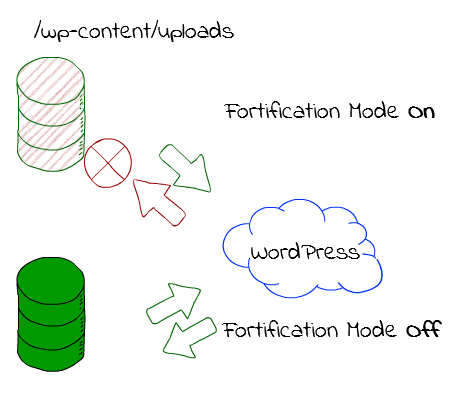Overview
Fortification Mode is a new feature introduced in apnscp as of May 2016. Fortification simplifies permission management for PHP-based applications, which run as a separate user from the account holder to enhance site security. Fortification mode is done within the control panel on a known application via Web > Web Apps.
When disabled, fortification mode allows write-access to any file under the document root of a hosted domain or subdomain. This is analogous to running the web application under your user account. When fortification is enabled, write-access is permitted to only select locations of a web application. Unless fortification permits it, the web application may not write to the destination.
Benefits of Fortification
Fortification yields two benefits:
First, in the event that your site is hacked, the attacker has limited mobility. Backdoors are frequently installed in system files that give the attacker multiple methods of re-entry once the initial ingress point has been secured (often, outdated software installed on that web site). Unless fortification explicitly permits write-access to those files, an attacker cannot install a backdoor. Those access points that the web application may write, e.g. /wp-content/uploads for WordPress or /administrator/cache in Joomla, are further limited by our security policies to disallow public access or serve only static content such as images, movies, or downloadable files.
Second, if a breach were to occur, running as a secondary user limits the scope of damage. An attacker is unable to snoop through your email, compromise your ssh keys, or gain access to the control panel. Damage is superficial at best. In addition, because these files are flagged with web application as its creator/owner, it makes audit trails very easy to establish allowing for us to quickly inoculate your site.
But, please – do stay on top of updates for your applications. Fortification is a feature to help keep your account secure, but it does not keep your account secure. Judicious use of third-party plugins, software updates, and strong passwords do. We cover automatic updates for WordPress, Joomla!, Drupal, and Magento, but there are thousands of web applications that users opt to install that are not enrolled in our automatic update program. Every time your account is compromised, a $15 fee is charged to the account.
Fortification Modes
Applications support a variety of fortification modes depending upon what support is provided in the control panel codebase. Only Learning Mode is enabled for unknown applications. For other supported applications, the following three fortification modes apply.
Learning Mode: if an application is not recognized or has not been previously detected, then Learning Mode is enabled. Learning Mode allows 100% write-access to the document root. After 30 minutes, a background task calculates what files have been modified, then establishes a fortification personality for that web site. Only files created or modified during that window will be allowed future write-access.
Fortification On (MIN): Minimum Fortification allows the greatest degree of freedom by the web application to write to and modify files. When enabled, you should never be prompted to change permissions on any files. Consequently, an attacker will have access to modify more files, including vital system files and potentially alter your .htaccess file – if present – to alter the way in which your web site is handled by the server.
Fortification On: Normal Fortification is the maximum reasonable fortification for a web site as established by our development team. You may need to alter permissions of files (or enable Web App Write Mode) to allow write-access in extreme situations, such as installing a new plugin or updating the application system files from its built-in update panel if supported by the web app and not supported by the control panel. Most paths are also filtered to serve assets as-is reducing the ability a hacker has to leverage secondary backdoors installed once the site becomes compromised.
Web App Write Mode: Web App Write Mode releases fortification on a 10 minute timer. After 10 minutes has elapsed, Normal Fortification is enabled. This is useful in situations where new plugins are installed or in-place updates are performed.
Release Fortification: disable fortification on the web app entirely and allow write-access to every file on the site to the web application. Typically very dangerous.
Fortification Visualized
The following diagram illustrates normal, min, and released fortification modes for WordPress.
See Also
- Fortification (apnscp.com)


